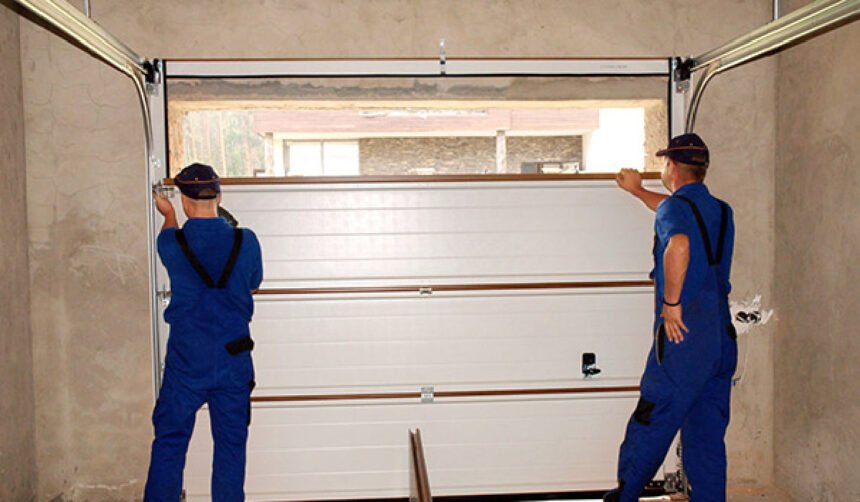Introduction
A garage door is more than just an entry point—it’s a crucial component of home security, energy efficiency, and daily convenience. Whether you’re building a new home or replacing an old, worn-out system, choosing and installing the right garage door is a major decision that can impact your property’s appearance, function, and value.
Proper garage door installation requires careful planning, precise execution, and a thorough understanding of various components. It’s not just about putting up a door; it’s about ensuring that the entire system—tracks, springs, opener, safety sensors, and more—functions harmoniously and safely.
This article explores everything you need to know about installing a garage door, from the different types and materials to professional vs. DIY installation, safety considerations, long-term maintenance, and more. Whether you’re a homeowner, contractor, or curious buyer, this guide offers the insights you need to make informed decisions and avoid costly mistakes.
Understanding the Importance of Garage Doors
A well-installed garage door offers more than just a sleek exterior—it serves a functional purpose in modern households and buildings. Some of its key benefits include:
- Security: A strong, properly functioning garage door protects your vehicle, tools, and other stored items from theft or vandalism.
- Convenience: With motorized openers and smart features, garage doors simplify daily routines.
- Insulation: Insulated garage doors can improve energy efficiency by regulating the temperature inside the garage, especially when attached to your home.
- Aesthetics: Modern garage doors come in a wide array of designs, colors, and materials, allowing them to complement the overall architecture of your home.
Given the important role garage doors play in daily life, it’s essential that they are installed correctly the first time with the help of an expert professional. For example, many homeowners in Australia choose and trust B&D Garage Doors in Sydney for installation and repair services because of their strong reputation.
Types of Garage Doors to Consider
Before starting the installation process, it’s important to understand the different types of garage doors available. Your choice can impact cost, functionality, and maintenance requirements.
1. Sectional Garage Doors
One of the most common types, sectional doors are made of panel sections connected with hinges. As the door opens or closes, wheels at the edge of each panel roll inside a vertical track.
2. Roll-Up Garage Doors
Often used in commercial spaces, these doors are made from small sections that roll around a drum above the opening. They are highly durable and space-efficient.
3. Side-Hinged Doors
These open and close from a hinged frame on either side of the opening. They offer a traditional look and are best suited for garages with plenty of space outside.
4. Tilt-Up Doors
These swing outward and then up into the ceiling of the garage. They offer a clean, seamless look but require more clearance in front of the garage.
5. Slide-to-Side Doors
These operate by bending to one side of the garage and sitting parallel to the wall. They are a good option when ceiling space is limited.
Materials: Choosing the Right One for Your Needs
Garage doors are made from various materials, each offering unique benefits and limitations:
• Steel
Highly durable and low-maintenance. Steel doors can be insulated and come in a wide range of styles.
• Aluminum
Lightweight and rust-resistant, but may be more prone to dents.
• Wood
Provides a classic, rich appearance but requires regular maintenance to prevent rot and damage from weather.
• Fiberglass
Resistant to moisture and insects but can fade over time when exposed to direct sunlight.
• Vinyl
Tough and dent-resistant, vinyl garage doors are often marketed as “kid-proof” and require little upkeep.
Selecting the right material depends on your climate, design preference, budget, and maintenance capacity.
The Garage Door Installation Process: Step-by-Step
A proper garage door installation involves multiple steps and should ideally be handled by trained professionals. Here’s what the typical process looks like:
Step 1: Measurements and Planning
The installer takes precise measurements of the garage opening, headroom, and side clearance. This helps in selecting the correct size and type of door.
Step 2: Removing the Old Door (If Applicable)
If you’re replacing an existing garage door, the old system—including the tracks, opener, and torsion spring—is carefully dismantled and removed.
Step 3: Setting the Tracks and Hardware
Vertical and horizontal tracks are installed, along with brackets and rollers. This provides the guiding system for the door panels to move up and down.
Step 4: Panel Installation
Door panels are stacked and attached, one section at a time, from the bottom up. Hinges are fastened between panels to allow them to bend during operation.
Step 5: Spring and Cable Setup
Whether using torsion or extension springs, this part of the process involves applying the proper tension to lift the door’s weight efficiently. It’s also one of the most dangerous parts and should only be performed by professionals.
Step 6: Opener Installation
The motorized opener is mounted to the ceiling and connected to the door via a lifting arm. Safety sensors are positioned near the floor to detect objects in the door’s path.
Step 7: Testing and Final Adjustments
After installation, the system is tested multiple times to ensure smooth operation. Adjustments to the spring tension, opener sensitivity, and alignment are made if needed.
Why Professional Installation Matters
While it might be tempting to try a DIY route to save money, garage door installation is a task that’s best left to experts for several reasons:
• Safety Concerns
Garage doors are heavy and operate under high tension. Mistakes during installation can lead to serious injury.
• Precision is Key
A slight misalignment in the tracks or improper spring tension can cause the door to malfunction or wear out faster.
• Time and Tools
Professionals have the specialized tools and experience needed to do the job efficiently.
• Warranty Protection
Most garage door manufacturers require professional installation to validate warranties.
By opting for expert garage door installation, you ensure that the system functions correctly, remains under warranty, and delivers optimal performance for years.
Cost Considerations
The cost of a new garage door installation can vary significantly depending on several factors:
- Type of door and material
- Insulation levels
- Manual vs. automatic operation
- Brand and design features
- Labor charges
While basic installations might be relatively affordable, premium doors with smart features, decorative hardware, and insulation will cost more upfront—but can offer long-term savings in energy efficiency and maintenance.
It’s advisable to get multiple quotes from reputable service providers, ensuring they include both material and labor costs in the estimate.
Smart Features and Modern Enhancements
Modern garage doors can include smart features that enhance convenience and security:
- Wi-Fi-enabled openers allow you to open or close the door from your smartphone
- Security cameras integrated into the opener system
- Battery backup systems to keep the door functioning during power outages
- Motion-activated lights for increased safety at night
- Keypad or biometric entry systems for added access control
While these upgrades increase the cost, they provide added functionality and peace of mind.
Maintenance After Installation
Once your new door is installed, regular maintenance ensures it continues to function safely and efficiently. Here’s what that looks like:
- Lubricating moving parts every six months
- Checking spring tension and cable wear
- Inspecting weather seals for air leaks or cracks
- Testing the auto-reverse mechanism
- Cleaning tracks and ensuring alignment
Scheduling annual professional inspections is a good idea, especially for systems that are used frequently.
Common Mistakes to Avoid
Even the best materials and designs can underperform if the installation is not done properly. Here are mistakes to avoid:
- Choosing the wrong size or type of door
- Poor insulation choices in extreme climates
- Failing to install safety sensors
- Incorrect spring tensioning
- Skipping professional help to save money
Avoiding these errors from the beginning will save time, money, and frustration down the road.
Conclusion
Garage doors are a central feature of any home or commercial building, contributing to functionality, security, and visual appeal. Proper garage door installation in San Antonio is critical to ensuring long-term performance, safety, and convenience. From choosing the right materials and design to ensuring accurate setup and maintenance, each step plays a vital role in the door’s lifespan.
While the upfront investment in professional installation might seem high, it pays off in durability, safety, and energy efficiency. Whether you’re replacing an old door or building a new space, make informed decisions and prioritize expert help for the best results.
For More Information, Visit Dotmagazine









